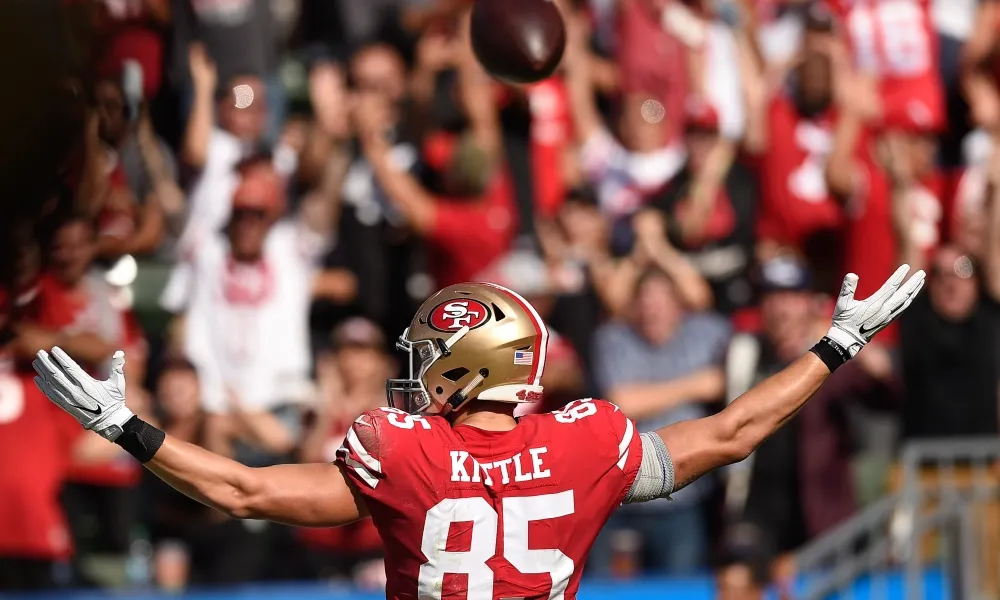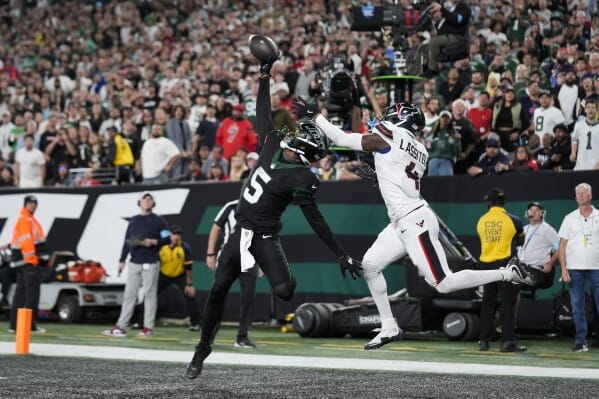
Stacking Keeps You Flexible
It's clear we're going to be talking about Week 17 correlation a lot this summer.
You know which side of the argument I'm on. My life-changing lineup included a farcical George Kittle/Hunter Renfrow mini correlation.
But I expect the pushback on Week 17 game stacking to have some legs this year. Following Underdog's decision to award more of the BBM4 prize pool to the regular season, there's an argument that playing for Week 17 is less important. At the very least, if you already thought the Week 17 stuff was overblown, more regular season prize money will likely reinforce that opinion.
However, Underdog's regular-season prize structure contributes to extremely top-heavy Week 17 payouts this year.
It's vital to understand this top-heavy payout structure in light of how difficult it is to make the finals in the first place.
The Difficult of Making the BBM4 Finals
If you max BBMIV as an average drafter, you can expect to advance 25 of your teams. (With an expected advance rate of 2-in-12, 150 entries would yield 25 playoff teams.) You'd then be expected to advance out of Week 15 at a 1-in-16 rate... for an expected semifinal showing of 1.6 teams.
With another 1-in-16 cutdown, maxing BBMIV is expected to advance just 0.1 teams to the finals. In other words, the expected rate of making the finals as a perfectly average drafter is just one team in 10 years.
That's pretty daunting.
Regular-Season Prizes
Fortunately, the finals aren't the only way to have a profitable season in the tournament.

Finishing at or near the top of the regular-season standings would be incredibly profitable. And these prizes provide another path to winning, independent of the playoffs. But you also have very long odds of a significant regular-season payday. Even finishing 51st out of 677,376 teams earns just $3,000—less than the $3,750 price tag to max enter the tournament.
And of the $5 million in regular-season prizes, $2.25 million will be paid out in $250 increments. These winnings will help reward a lot of different drafters for excellent teams. But those prizes aren't what we're playing for.
Finishing First
Although BBM now has more regular-season prizes, the top money is still in Week 17. The top payout in Week 17 is now 6x as large as the regular-season first-place prize, after being only 2x last season. I plan to play for the top prize.
But, given what I laid out above, simply making the Week 17 finals is already a considerable achievement. And yet, if you completely flame out in the finals, it's going to hurt. A ticket with a realistic shot of cashing for $3 million comes with a min-cash of just $1,000.
Moreover, finishing 51st—in the 88th percentile—is worth only 5x a last-place finish. Granted, $5,000 is a nice chunk of change, but it's still 600x less than the first-place prize.
Even finishing 11th—a top 3-percentile finals outcome—pays out 200x less than the first-place prize.
Hell, finishing third is worth 10x less than finishing first. This is not a tournament where you're just happy to be there in Week 17. You need to play to finish first.

Game Stacking Increases Weekly Ceiling
Fortunately, there are some levers we can pull to increase our odds of finishing not just near the top but at the very top. And... one of these is to game stack Week 17.
In his Best Ball Manifesto, Mike Leone found game stacking to be a pivotal contributor to expected value.
"The data shows that your ability to win a 470-person field can increase by ~50% by game stacking."
"In Week 17, ideally, you have between 6-9 total game-stacked players, where a player is considered “game-stacked” if they are on the same team as your QB or any opposing skill player."
Leone's findings were based on all 17 weeks of 2022 data, which increases the odds that game stacking is meaningfully adding ceiling to best ball lineups. In other words, his findings aren't simply reflecting what happened in one week last season.
But this means that Leone's research used non-playoff weeks. Most stacks in these weeks – Week 6 or what have you – were created without intent. And because those stacks were created by chance... they were likely put together without reaching.
This is one of the most important things to remember when attempting to build out Week 17 game stacks—correlation is an edge as long as we're also following drafting fundamentals.
Adam Levitan recently reiterated this point.
Unpopular Best Ball take: Week 17 correlation is definitely +EV. We should try to have it, especially in BBM payout structure. But it's not among the top-5 things I'd think about when on the clock:
— Adam Levitan (@adamlevitan) May 11, 2023
* Roster Construction
* Stacking
* ADP
* Player ranks/takes
* Positional capital
If you are newer to best ball, Adam's framing is what I recommend. In addition to thoughtfully thinking through your exposures, Adam's list covers the best ball fundamentals. These concepts are the blocking and tackling of fake football.
And you can't ignore the fundamentals of the game, or you'll have no chance of making the finals in the first place.
But, if you're comfortable with the basics, you may not be thinking about correlation enough.
Accomplishing Multiple Things at Once
If you don't think about correlation at all but expertly execute best ball fundamentals, you'll likely have an excellent advance rate. And based on Leone's Best Ball Manifesto, playoff advance rate probably is underrated, at least among hardcore drafters.
However, a pure advance rate-style drafter is likely leaving serious value on the table by not optimizing for the top prize in Week 17. And, again, a respectable showing is not what we're playing for; we're playing for first place.
At the same time, a drafter who zones in on correlation at the expense of the fundamentals is likely to have an incredible Week 17 team... that never makes the Week 17 final.
The goal is to do both things at once.
Staying Flexible
One of the potential mistakes that drafters can make when building stacks of any kind is getting overly focused on "completing" the stacks they've started.
Sometimes, it does make sense to draft this way. If you draft a quarterback without stacking partners, it makes sense to prioritize pairing him with at least one pass catcher. But... if you've drafted the pass catcher(s) first, I recommend fighting the urge to become overly focused on "finishing" that stack with a QB selection.
Instead, we want to be thinking about building in correlation throughout the draft, even without the quarterback—which I outline here:

Stacking without the quarterback isn't just a helpful backup plan for when you get sniped; it's a vital part of what I'm trying to do in every draft.
Because, in my experience, building a fundamentally sound team with Week 17 correlation is far more manageable when I'm attempting to game stack more frequently, not less.
When I think about correlation more, the difficulty of adding it in drops because I'm willing to build teams with several "incomplete stacks".
Except, I don't call them incomplete stacks; I call them mini correlations or mini game stacks.
But the point is, building "incomplete stacks" is something I'm actively looking to do—because stacking increases my flexibility throughout the draft.
BBM4 Example
Take this Best Ball Mania IV draft as an example:


This is far from a perfect draft, and I'm annoyed that I was boxed into Mac Jones as my QB2—functionally giving me just one path to a tournament-winning QB performance in Week 17. But it still provides some good examples of the approach I'm outlining.
Early Rounds
I grabbed Stefon Diggs past ADP in Round 1 and then reached slightly to secure an Allen/Diggs stack.
I lucked out big time when Rhamondre Stevenson then fell to the 3.10. Stevenson accomplished four things at once:
- He made structural sense as my RB1.
- He's a target at ADP.
- He was an ADP value.
- He creates a Bills/Patriots Week 17 game stack.
Stevenson was a no-brainer. The only credit I can take is drafting early enough in the offseason for a starting three-down RB to fall to the end of the third round.
Rounds 4-6: Prioritizing Structure
Week 17 wasn't top of mind for any of these three picks. Instead, I was focused on structure.
Last year, I argued for at least four WRs through nine rounds on Underdog. Hayden Winks has argued for even more early WR firepower; his golden rule calls for four WRs through seven rounds. Given that WRs are more expensive after dominating in the early rounds last year, I'm prioritizing Hayden's rule over my more lax rule of thumb. It's vital to get enough WR firepower before it's gone.
And with only one WR through three rounds, I needed to prioritize the position. So in Round 4, I reached slightly for Mike Williams. Williams isn't my favorite player, but he's a solid starter on a good offense and helped me stay on schedule at WR.
I then grabbed Jaxon Smith-Njigba in Round 5 to remain on schedule.
Kyle Pitts was an easy click in Round 6, given the evidence that elite tight end provides a major edge in best ball tournaments.

Rounds 7 and 8: Staying within Structure
Entering Round 7 with only three WRs, my structure was my primary concern. And I got lucky. At 7.11, Gabe Davis allowed me to stay on schedule at WR and provided a double stack with Josh Allen.
Selecting Davis let me shift my focus to RB and I was able to grab Rachaad White 10 picks past ADP. I have White ranked as a target, so getting him at a discount was a bonus. He also makes sense as an RB2, given his clear path to playing time early in the season.
Rounds 9-10: Avoiding Reaches
In Round 9, I grabbed my WR5. Pete Overzet has identified taking five WRs through nine rounds as a key element of last year's winning lineups. Hayden Winks also found 5-6 WRs through 10 rounds as optimal last season, up from 4-6 in 2020-21.
I'm lukewarm on Courtland Sutton specifically; I have him about even with ADP in my best ball ranks.
But selecting Sutton accomplished three things at once:
- I stayed within structure.
- I scooped an 11-pick ADP value.
- I completed a Week 17 mini correlation with Mike Williams.
Crucially... I did not select JuJu Smith-Schuster, who would have added to my Week 17 Bills/Patriots stack. JuJu would have been a slight reach by ADP and is currently 16 spots lower in my rankings than Sutton.
If all I cared about was my primary game stack, I would have had to make serious compromises to add correlation.
But I didn't have to chase the correlation with JuJu because I was thinking about building out additional correlation beyond my primary team stack.
In Round 10, I avoided another reach by passing on Russell Wilson. Reaching on a skill player isn't great. But I definitely didn't want to reach for Wilson on a Josh Allen team after literally daring the best ball community to snipe my QBs. And we're talking about a big reach. Grabbing Wilson would have meant sacrificing 17 picks of ADP. That would have turned my ADP value on Sutton into an overall loss since it would have directly led to a significant reach on Wilson.
Instead, I grabbed Damien Harris six picks ahead of ADP. Harris was a minor reach, but it made a lot more sense structurally to grab my RB3 in the 10th than my QB2, given what I'd spent on each position so far.
I got some correlation with the pick as well.
In this case, though, Harris isn't adding to my Week 17 ceiling. In fact, he's negatively correlated with the type of ceiling outcomes I need from an Allen double stack. But the math changes when looking at the entire year. Over the whole season, Allen and Harris are positively correlated. As Mike Leone wrote in 2021: "If the offense rolls, everybody rolls."
None of this would matter if I had three strong RBs to this point and was hunting for RB upside. But in this build, Harris makes sense on his own as an advance-rate RB3 play. Harris is a veteran RB with a projectable committee role on a great offense. The fact that I'd already made a massive bet on that offense to have an excellent season is a delightful bonus. Whether or not I take Harris, this team's fate hinges on the Bills lighting up scoreboards. Selecting Harris means that if they do, my high-upside double stack is more likely to have a chance to make it to the playoffs, where its ceiling is most necessary.
Rounds 11-18: Adding Correlation and Closing Line Value
Russell Wilson went at 11.08, two spots before my pick in the 11th. Wilson isn't a big target for me, but he would have made sense for this build at a slight value. Instead, I pivoted to Rashee Rice as my WR6, scooping a rookie who I expect to be a riser this summer.
I then grabbed Cole Kmet and Tyler Allgeier at slight ADP discounts. Paired with Pitts, those three form a Week 17 mini game stack. Given that the Falcons' Week 17 tilt with the Bears is likely to generate ~11 total plays... it's not my top Week 17 stacking target. But tight end scoring is highly volatile, and Allgeier has high-end contingent value. It's not hard to imagine a world where all three players score a TD if both offenses move the ball efficiently. And critically, the ancillary pieces of the stack were cheap and below ADP.
In Round 14, I grabbed Ezekiel Elliott. Zeke is never a fun click, but as Sam Sherman and I discussed on ADP Chasing, drafting veteran RBs before they sign has been a solid way to find closing line value. And finding closing line value is one of the reasons to draft early.
In Round 15, I grabbed Marvin Mims. I view Mims as a priority target but selected him after ADP. In this build, he has the added bonus of turning my Mike Williams/Courtland Sutton mini correlation into a mini game stack. Keep in mind that despite being sniped on Russell Wilson, I continued to build out this game stack.
I finished the draft by grabbing Tyquan Thornton, Mac Jones, and Deonte Harty. All three were slight reaches but allowed me to continue betting on the Bills/Patriots in Week 17 while also pairing my QB2 with a WR (instead of just a pass-catching RB).
Having two QBs from the same game is not ideal—given that I paired Josh Allen with three WRs, Mac Jones is not a realistic Week 17 option. If Jones hits my Week 17 starting lineup, this team is dead for first place.
But I view Jones as a functional QB2 when paired with an elite QB. His role comes down to keeping his job and filling in for a couple of weeks... and maybe helping out in Weeks 15-16.
Week 16 Bonus Correlation
Although Mac Jones is not an ideal QB2 on a Josh Allen team, the pair work better than other QBs who play each other in the finals—because the Bills and Patriots form a four-team group with the Chargers and Broncos.
The Patriots play at Denver in Week 16, and the Bills play in Los Angeles. So my Broncos/Chargers Week 17 stack also creates two full game stacks in Week 16.
This is why I'd still prefer Jones to risking an unstacked QB2. Jones has very low odds of mattering in Week 17; Allen will be the guy you need if the game shoots out. But having him paired with Thornton and Stevenson could still be very helpful in Week 15 or 16 if things shake out a certain way.
Given how hard it is to advance through the playoffs, it's helpful to at least consider Week 15-16 bonus correlations and which groups of teams provide them.
This thread has some good ones:
Neat schedule bit (with few good options): NYG NO LAR
— David (@DSP4150) May 13, 2023
Week 15: NO NYG
Week 16: NO LAR
Week 17: LAR NYG
Kupp-Olave start... you get a pocket from r7-9 on Waller/Akers-MT-Kamara/DJones... land the plane with JWill/Kendre/ZEvans, Hyatt/WDR/Hodgins, Carr/Stafford, Taysom/Juwan
Drafting Tip
It occurred to me that I should share how I kept track of my various correlation options in this fast draft: Every time I drafted a player from a new team, I searched for that team and starred all the players I considered draftable for the build. I then did the same for that team's Week 17 opponent. (It helps to memorize the schedule to speed this process up).
Davis Mattek taught me this trick last year, and it's been a huge help... just don't time out.
If you prefer a clean queue, Spike Week has tools to help track correlation during the draft. (As a LegUp subscriber, promo code LEGUP gets you 40% off a Spike Week subscription).
The Big Picture
The biggest weakness of this team is that it has only one obvious out for a huge Week 17: Josh Allen.
However, if Allen goes off... then things are pretty simple. In addition to a nuclear skill-player performance or two, I need points from the Chargers/Broncos and Falcons/Bears. So although the fate of this team is heavily tied to Allen, I still stand to benefit from two other games popping off—because I planned out a variety of correlation options throughout the draft.
Stayed within Structure
Because I wasn't overly focused on specific correlations, I built a highly-correlated team with sufficient WR firepower that also found room for an elite QB and an elite TE.
At RB, per the Best Ball Manifesto, my total capital spent fell in Bucket 5. In other words, I didn't spend much at the position. But this worked out exceptionally well last year.

Moreover, I didn't ignore RB. I value-hounded an early target and grabbed four RBs through Round 13. Last year, I identified four RBs through Round 13 as a good rule of thumb. And Hayden Winks found that drafting 4-5 RBs through Round 13 was optimal last year. I also didn't wait around for my RB5, grabbing my last RB in Round 14 before returning to WR and QB to close things out. So although I didn't spend much at the position, I still spent enough to have a chance of hitting on some upside.
In terms of classic roster construction definitions, this team falls through the cracks. But it's still structurally sound across all four positions. One way to think about it is that I opted to treat Rhamondre Stevenson as an Anchor RB. Even though I took Stevenson later than usual for that approach, the build still fits the tenets of that structure.
Scooping Value and Targets
Despite reaching for a Diggs/Allen stack to start the draft, I ended up with positive draft capital value overall.
I avoided a bring-back reach on a player I'm not targeting (JuJu Smith-Schuster) by scooping an ADP value, who added correlation in another game. And I refused to reach on QB2 despite a correlated option being available.
As a result, I ended up with a big Week 17 game stack and two Week 17 mini stacks while scooping ADP values and players I liked.
Balancing Exposures
My focus on building out mini correlations also encouraged me to take Cole Kmet, a player who I've taken only one other time in 43 drafts since the NFL Draft.
And I don't dislike Kmet; I'm six spots ahead of ADP on him in my rankings. But for whatever reason, I just haven't ended up with him. So in that sense, using correlation as a tiebreaker helped me avoid going significantly underweight on a player I'm not planning to fade.
I sometimes need help keeping my exposures in line with what I'd set them at in a vacuum. Correlation helps me manage that issue by encouraging me to stray from the beaten path.
Stacking Keeps You Flexible
We want to execute best ball fundamentals in every draft. That is indisputable.
But game stacking Week 17 is not at odds with the fundamentals.
If you think about it, it's not like the fundamentals are always in line with one another. Sure, if you need a WR4, it's pretty incredible when your favorite Round 7 WR falls to you at a value... but things don't always play out like that. We often need a tiebreaker.
We're constantly balancing ADP value, player takes, structure, and exposures during our drafts. But as long as you're comfortable with those fundamentals, Week 17 correlation doesn't get in the way of that process. In fact, it can operate alongside those fundamentals as a helpful and often necessary tiebreaker throughout the draft.
And when engaged throughout the entire draft, correlation makes your teams more flexible as the draft goes on. It gives you more options later in the draft and makes you more resilient to snipes that would tilt a lesser drafter's face off. In other words, if built into your drafting philosophy, correlation becomes a tool for building more fundamentally sound teams and more thoughtful portfolios.
It also doesn't hurt that if one of your game-stacked teams makes it to the finals... it will be optimized to slingshot to the top of the leaderboard.

Full Newsletter Archive

Details on $50 Underdog Credit, 40% off Spike Week, Discord Access, Premium Podcast Feed



